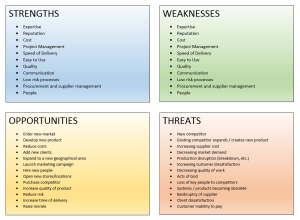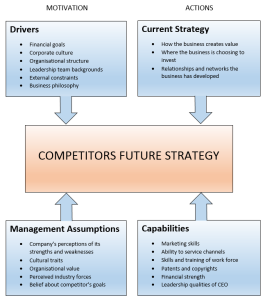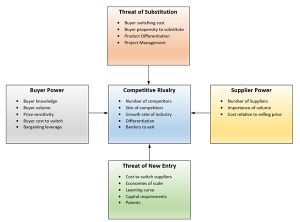
A strategic plan documents the methods by which an organization achieves its corporate goals. We at ProjectEngineer have developed the best free strategic planning template on the internet, and we offer it to you here as a free download ([download id=”2006″] | [download id=”2009″]). A strategic plan contains the following 10 key parts:
- Mission statement
- Corporate goals
- Key Performance Indicators
- Strengths and Weaknesses
- Opportunities
- Threats
- External factors
- Competitors analysis
- Market analysis
- Financial projections
Mission Statement
This is the foundation of a strategic plan. A mission statement should contain the purpose of the organization stated from a customer perspective. Why does the company exist? When you go to the registry office (in my state) and fill out papers for the formation of a company, which I have done several times, there is a fairly obvious reason why you are doing what you are doing. Large, established companies may have lost it in the noise over the years, but they should have a similar ability to identify the reason for its existence. The mission statement should encapsulate that reason and provide the cornerstone of the organization’s existence. Examples of mission statements are:
- To become the best value supplier.
- To fill the demands of our customers quickly, accurately, and economically.
- To dominate the markets we compete in.
Non-profits and governmental organizations can have equally valid mission statements, even if the end goal is not financial. In fact, I’ve seen non-profits that should be teaching the corporate world about defining, pursuing, and achieving strategy.
Corporate Goals
Goals are the specific things for which an organization strives in the accomplishment of its mission. They represent the breaking down of the mission statement into specific items that can be focused on by all the different work teams. They should be quantifiable and measurable. They are the “path” to reach the mission, and consist of a 3-5 year time frame. Examples of corporate goals are:
- Grow revenue by 20%/year.
- Become the lowest cost supplier.
- Reduce costs by 10%.
Corporate goals can be used to identify and manage projects which implement the various initiatives.
Key Performance Indicators
Called KPI’s for short, Key Performance Indicators are the individual metrics which get tracked and reported on a regular basis. These represent the hard data that keeps everyone accountable. Line production managers should be measuring and reporting the number of widgets produced, department managers should be reporting the number of defective widgets, and so forth. Other examples are:
- Number of clients
- Number of units sold
- Project schedule variance
- Delivery time
- Market share
If you do nothing else, make sure you have strong KPI’s in place for your organization and report them to the appropriate management level on a regular basis.
Strengths and Weaknesses
A SWOT analysis evaluates the competitive situation of your organization in an effort to determine its most profitable future direction. SWOT stands for Strengths-Weaknesses-Opportunities-Threats. Each of these is plotted on a 2×2 matrix.
The SWOT analysis is a nifty tool that gives you a big picture overview of the important elements in your organization’s path and helps you visualize the best path to take.
Opportunities
Opportunities represent the actions that the organization can take which hold the most potential for profit (or service level, in the case of a non-profit). Opportunities itemize the market imbalances that the corporation is addressing with its goals and strategy.
The SWOT analysis is also the primary tool for this section. Opportunities such as adding new features, developing new products, and opening new stores can be itemized in this section.
Threats
Every organization exists in a world where possible events threaten the achievement of the goals of the company. A prudent strategic plan will include a thorough analysis and response plan. Threats can economic, such as market demand, or from competitors. They can be uncontrollable or result from inadequate preparation.
Threats are the fourth and final quadrant in the SWOT analysis and should be identified and discussed in the strategic plan.
External Factors
This part of a strategic planning template identifies the external factors that affect an organization. Often these factors are out of the control of the organization and represent risk mitigation factors rather than action items. But it’s a valuable part of the template. A PEST analysis is an invaluable tool that identifies the following four categories of external factors:
- Political factors like government regulations, environmental laws, and taxes. Tariffs, trade restrictions and political instability.
- Economic factors such as product demand, inflation, interest rates, currency exchange rates and economic growth rates.
- Social factors like consumer sentiment toward a product, population growth, and demographics.
- Technological factors that force investment in product upgrades or cost reductions, or that makes products obsolete.
Competitors Analysis
This portion of the strategic planning template analyzes the competition and attempts to determine their future strategy. It is an attempt to guesstimate the competition’s likely response to external events, or your strategy. A four corners analysis is a great tool which assists in this section. The “four corners” are:
- Drivers: The “existing situation” which identifies what motivates the competitor’s actions or strategy.
- Management Assumptions: The competitor’s actions are determined by the perceptions they have about themselves, their abilities, weaknesses, and opportunities (essentially, their SWOT analysis).
- Strategy: The competitor’s existing corporate strategy, including things like where it is investing its profits and creating value.
- Capabilities: The competitor’s strengths will be where they naturally focus their efforts (if they were smart, but we have to assume they are).
Although the strategic plan is primarily about yourself and your strategy, a basic analysis of the competition is a valuable part.
Market Analysis
A market analysis determines the attractiveness of a market for the purpose of doing business. This section develops the supply and demand for the products and services the organization offers, and their future direction.
A Five Forces analysis is the primary tool in this section. In a five forces analysis, the following five items are discussed and plotted on a 5-box matrix.
- Supplier power: The ability of suppliers to raise prices. This depends on the number of suppliers in the marketplace, the uniqueness of their product, and the ability to switch suppliers.
- Buyer power: The ability of buyers to drive prices down. This depends on the number of buyers in the marketplace and the ability of a buyer to switch suppliers.
- Competitive Rivalry: The competitive landscape, including the number of competitors and their relative strength.
- Threat of Substitution: The number of substitute products in the marketplace, or the ability of a competitor to develop one.
- Threat of New Entry: The barriers to entry. Clearly, if it is very easy to get into the market, stiff competition can be expected, even if there currently is very little.
Financial Projections
A financial projection helps to determine if a goal is worth achieving. Each corporate goal and KPI should be considered and the resulting impact on the organization calculated. A simple spreadsheet is usually enough. The strategic plan should take the mission statement, and the resulting KPI’s, and itemize the financial effects so that everyone knows what the actual benefits of achieving the goals are.
Take a look at our [download id=”2034″] for a good outline of a strategic plan and comprehensive checklists for everything you might need.









